-
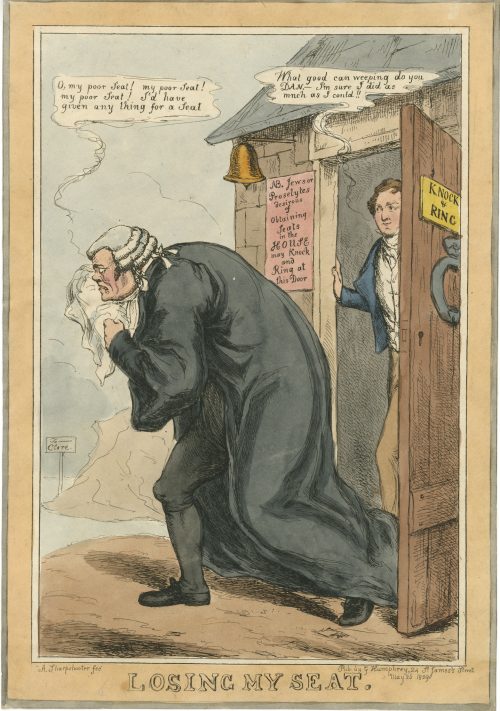 Hand-coloured etching by an anonymous British artist, printed on May 26, 1829, in London. Description by British Museum (1868,0808.8988): "O'Connell, in wig and gown, walks to the left from the massive door of a small stone building, stooping, and holding his handkerchief to his right eye. He wails: 'O, my poor Seat! my poor Seat! my poor Seat! I'd have given any thing for a seat.' In the doorway (right) stands Peel, saying with wary blandness: 'What good can weeping do you Dan.—I'm sure I did as much as I could!!' Above the large knocker on the plank door is 'Knock & Ring'. There is a projecting bell, above a placard: 'NB. Jews or Proselytes desirous of Obtaining Seats in the House may Knock and Ring at this Door.' One corner of "the House", a small stone shed, is depicted. O'Connell is walking towards a strip of water, across which is a mountain, with a board pointing 'To — Clare'. Comment by BM: "Catholic Emancipation raised high hopes among Jews; the first Bill, after a petition from Jews in Liverpool, was introduced 15 Apr. 1830, but Jewish Emancipation did not become law till 1858." Inscription under the frame with title, "A. Sharpshooter fec", text within image and publication line: "Pub. by G. Humphrey, 24 St. James's Street May 26 1829". Size: 37.5 x 26 cm.
Hand-coloured etching by an anonymous British artist, printed on May 26, 1829, in London. Description by British Museum (1868,0808.8988): "O'Connell, in wig and gown, walks to the left from the massive door of a small stone building, stooping, and holding his handkerchief to his right eye. He wails: 'O, my poor Seat! my poor Seat! my poor Seat! I'd have given any thing for a seat.' In the doorway (right) stands Peel, saying with wary blandness: 'What good can weeping do you Dan.—I'm sure I did as much as I could!!' Above the large knocker on the plank door is 'Knock & Ring'. There is a projecting bell, above a placard: 'NB. Jews or Proselytes desirous of Obtaining Seats in the House may Knock and Ring at this Door.' One corner of "the House", a small stone shed, is depicted. O'Connell is walking towards a strip of water, across which is a mountain, with a board pointing 'To — Clare'. Comment by BM: "Catholic Emancipation raised high hopes among Jews; the first Bill, after a petition from Jews in Liverpool, was introduced 15 Apr. 1830, but Jewish Emancipation did not become law till 1858." Inscription under the frame with title, "A. Sharpshooter fec", text within image and publication line: "Pub. by G. Humphrey, 24 St. James's Street May 26 1829". Size: 37.5 x 26 cm. -
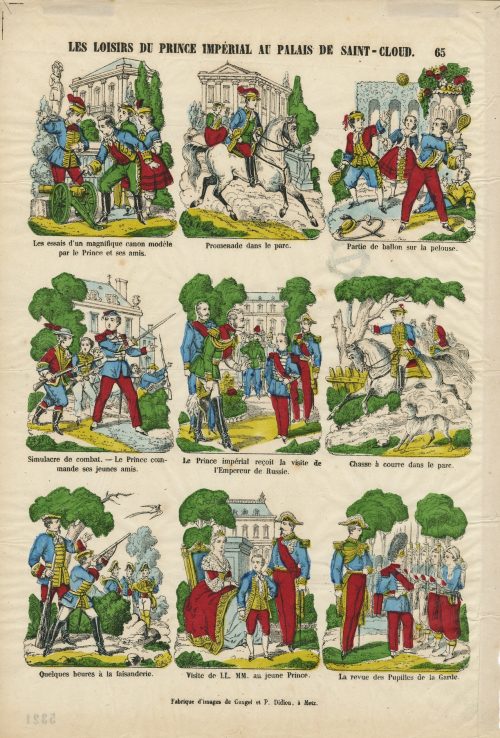 Hand-coloured woodcut on wove paper, 400 x 280 mm; black ink stamp “5321” to reverse. Top: "LES LOISIRS DU PRINCE IMPERIAL AU PALAIS DE SAINT- CLOUD" — "65". Below: nine cartoons with captions.
Hand-coloured woodcut on wove paper, 400 x 280 mm; black ink stamp “5321” to reverse. Top: "LES LOISIRS DU PRINCE IMPERIAL AU PALAIS DE SAINT- CLOUD" — "65". Below: nine cartoons with captions.- Les essais d'un magnifique canon modèle par le Prince et ses amis.
- Promenade dans le parc.
- Partie de ballon sur la pelouse.
- Simulacre de combat. — Le Prince commande ses jeunes amis.
- le Prince impérial reçoit la visite de l'Empereur de Russie.
- Chasse à courre dans le parc.
- Quelques heures à la faisanderie.
- Visite de LL. MM. au jeune Prince.
- La revue des Pupilles de la Garde.
-
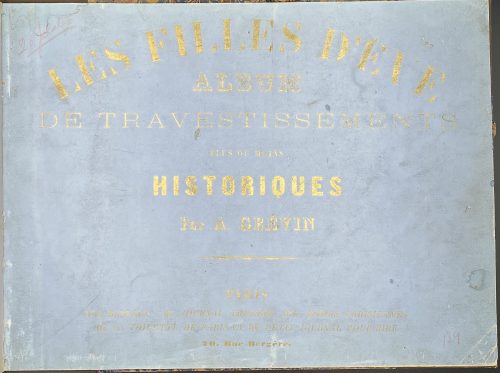 Pictorial album of 20 hand-coloured wood engravings by Firmin Gillot after Alfred Grévin; numbered 1 to 20, bound with tissue guards in half-brown cloth over marbled boards, publisher's gilt-lettered blue wrappers preserved, purple-blueish endpapers. Front wrapper (gilt on blue): LES FILLES D'EVE | ALBUM | DE TRAVESTISSEMENTS | PLUS OU MOINS | HISTORIQUES | Par A. GRÉVIN | — | PARIS | AUX BUREAUX : DU JOURNAL AMUSANT, DES MODES PARISIENNES | DE LA TOILETTE DE PARIS ET DU PETIT JOURNAL POUR RIRE | 20. Rue Bergère. || ; Henri Plon's imprint to back wrapper. Contributors: Grevin, Alfred (French, 1827 – 1892) Gillot, Firmin (French, 1820 – 1872) Plon, Henri (French, 1806 – 1872) Ref.: Metropoliten Museum.
Pictorial album of 20 hand-coloured wood engravings by Firmin Gillot after Alfred Grévin; numbered 1 to 20, bound with tissue guards in half-brown cloth over marbled boards, publisher's gilt-lettered blue wrappers preserved, purple-blueish endpapers. Front wrapper (gilt on blue): LES FILLES D'EVE | ALBUM | DE TRAVESTISSEMENTS | PLUS OU MOINS | HISTORIQUES | Par A. GRÉVIN | — | PARIS | AUX BUREAUX : DU JOURNAL AMUSANT, DES MODES PARISIENNES | DE LA TOILETTE DE PARIS ET DU PETIT JOURNAL POUR RIRE | 20. Rue Bergère. || ; Henri Plon's imprint to back wrapper. Contributors: Grevin, Alfred (French, 1827 – 1892) Gillot, Firmin (French, 1820 – 1872) Plon, Henri (French, 1806 – 1872) Ref.: Metropoliten Museum. -
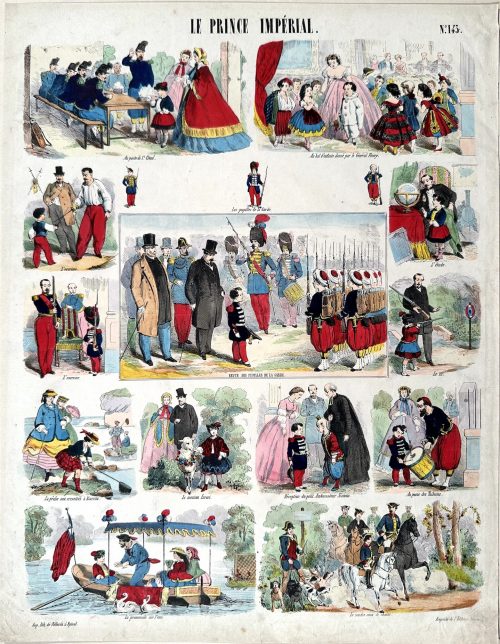 Hand-coloured woodcut on wove paper, 472 x 365 mm; black ink stamp “5275” to reverse. Top centre: "LE PRINCE IMPÉRIAL"; right: "№143." Image in the middle: Prince Impérial, with his father, conducts a review of the children's army "REVUE DES PUPILLES DE LA GARDE". Besides – five tiers of captioned cartoons. Bottom left: "Imp. lith. de Pellerin à Épinal"; right: Propriété de l’Éditeur. Déposé." Jean Charles Pellerin (French, 1756 – 1836) – printer/publisher.
Hand-coloured woodcut on wove paper, 472 x 365 mm; black ink stamp “5275” to reverse. Top centre: "LE PRINCE IMPÉRIAL"; right: "№143." Image in the middle: Prince Impérial, with his father, conducts a review of the children's army "REVUE DES PUPILLES DE LA GARDE". Besides – five tiers of captioned cartoons. Bottom left: "Imp. lith. de Pellerin à Épinal"; right: Propriété de l’Éditeur. Déposé." Jean Charles Pellerin (French, 1756 – 1836) – printer/publisher. -
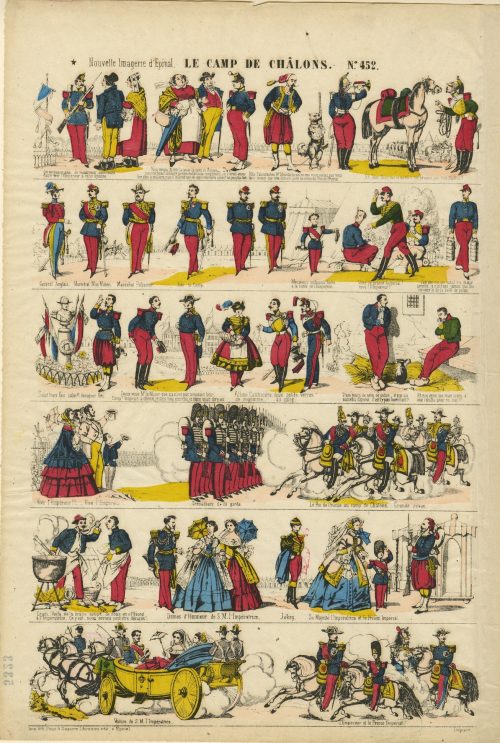 Hand-coloured woodcut on wove paper, 409 x 280 mm; black ink stamp “5323” to reverse; attached to the sheet 487 x 320 mm. Top centre: "LE CAMP DE CHALONS."; left: "Nouvelle Imagerre d'Epinal"; right: № 452. Bottom left: "Imp lith. Pinot & Sagaire, libraires edit. à Épinal"; right: "Déposé". Image: 6-tier cartoon with captions about Napoleon III and his son Prince Imperial (Napoléon Eugène Louis Jean Joseph Bonaparte; 16 March 1856 – 1 June 1879). Le camp de Chalons Pinot & Sagaire (Épinal, 1861 – 1888) – enterprise, publisher/printer. Charles-François Pinot (French, 1817 – 1879) – publisher/printer.
Hand-coloured woodcut on wove paper, 409 x 280 mm; black ink stamp “5323” to reverse; attached to the sheet 487 x 320 mm. Top centre: "LE CAMP DE CHALONS."; left: "Nouvelle Imagerre d'Epinal"; right: № 452. Bottom left: "Imp lith. Pinot & Sagaire, libraires edit. à Épinal"; right: "Déposé". Image: 6-tier cartoon with captions about Napoleon III and his son Prince Imperial (Napoléon Eugène Louis Jean Joseph Bonaparte; 16 March 1856 – 1 June 1879). Le camp de Chalons Pinot & Sagaire (Épinal, 1861 – 1888) – enterprise, publisher/printer. Charles-François Pinot (French, 1817 – 1879) – publisher/printer. -
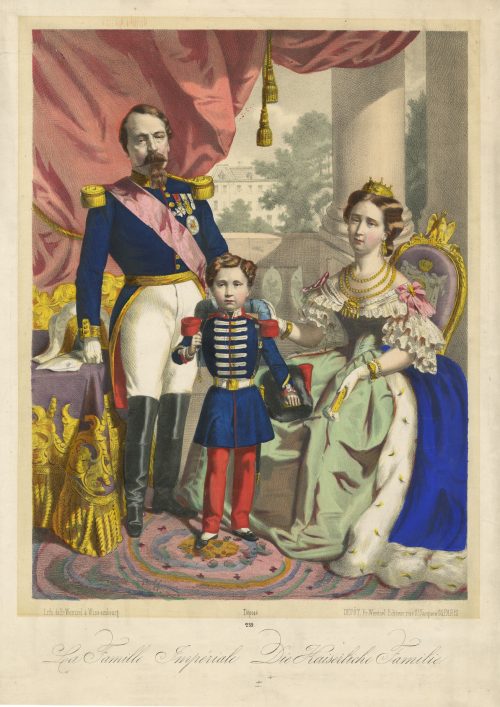 Hand-coloured lithography on wove paper, 395 x 280 mm; black ink stamp “5309” to reverse. On image: artist's initials "L. H."; on stone: "Lith. de Fr. Wentzel a Wissembourg. — Déposé — DÉPÔT, Fr. Wentzel Editeur rue St. Jacques 65, PARIS"; below centre: "239"; bottom : La famille Impériale. Die Kaizerliche Familie. Napoleon III [Charles-Louis Napoléon Bonaparte] (French, 1808 – 1873) Eugénie de Montijo [L'impératrice Eugénie] (Spanish-French, 1826 – 1920) Napoléon, Prince Imperial (Napoléon Eugène Louis Jean Joseph Bonaparte] (French, 1856 – 1879) Jean Frédéric Wentzel (French, 1807 – 1869) – publisher/printer.
Hand-coloured lithography on wove paper, 395 x 280 mm; black ink stamp “5309” to reverse. On image: artist's initials "L. H."; on stone: "Lith. de Fr. Wentzel a Wissembourg. — Déposé — DÉPÔT, Fr. Wentzel Editeur rue St. Jacques 65, PARIS"; below centre: "239"; bottom : La famille Impériale. Die Kaizerliche Familie. Napoleon III [Charles-Louis Napoléon Bonaparte] (French, 1808 – 1873) Eugénie de Montijo [L'impératrice Eugénie] (Spanish-French, 1826 – 1920) Napoléon, Prince Imperial (Napoléon Eugène Louis Jean Joseph Bonaparte] (French, 1856 – 1879) Jean Frédéric Wentzel (French, 1807 – 1869) – publisher/printer. -
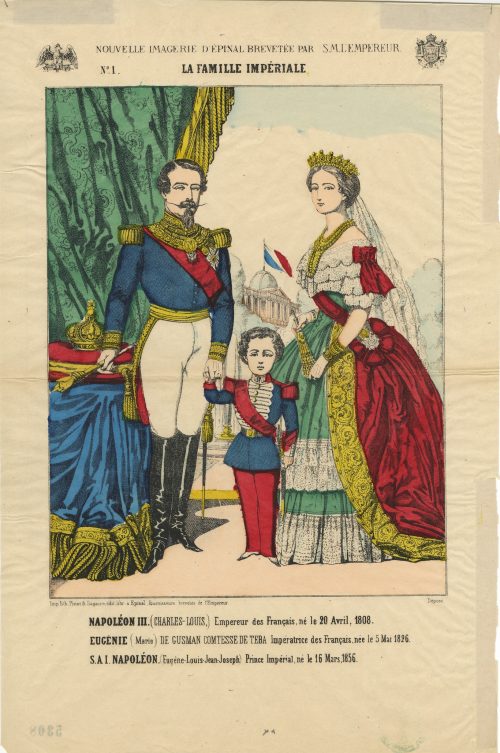 Hand-coloured woodcut on wove paper, 390 x 260 mm; black ink stamp “5308” to reverse; horizontal centerfold. Centre top: "NOUVELLE IMAGERIE D'ÉPINAL BREVETÉE PAR S.M.L’EMPEREUR" with imperial eagle and coat of arms at right and left. Below: "№ 1." — "LA FAMILLE IMPÉRIALE"; image in frame; under the image, left: "Imp lith. Pinot & Sagaire, édit. libr. à Épinal, fournisseurs brevetés de l’Empereur"; right: "Déposé". Bottom: "NAPOLÉON I. (CHARLES-LOUIS,) Empereur des Français, né le 20 Avril, 1808. | EUGÉNIE ( Marie) DE GUSMAN COMTESSE DE TEBA Impératrice des Français, née le 5 Mai 1826. | S.A I. NAPOLÉON. (Eugène-Louis-Jean-Joseph) Prince Impérial, ne le 16 Mars. 1856." Napoleon III [Charles-Louis Napoléon Bonaparte] (French, 1808 – 1873) Eugénie de Montijo [L'impératrice Eugénie] (Spanish-French, 1826 – 1920) Napoléon, Prince Imperial (Napoléon Eugène Louis Jean Joseph Bonaparte] (French, 1856 – 1879) Pinot & Sagaire (Épinal, 1861 – 1888) – enterprise, publisher/printer. Charles-François Pinot (French, 1817 – 1879) – publisher/printer.
Hand-coloured woodcut on wove paper, 390 x 260 mm; black ink stamp “5308” to reverse; horizontal centerfold. Centre top: "NOUVELLE IMAGERIE D'ÉPINAL BREVETÉE PAR S.M.L’EMPEREUR" with imperial eagle and coat of arms at right and left. Below: "№ 1." — "LA FAMILLE IMPÉRIALE"; image in frame; under the image, left: "Imp lith. Pinot & Sagaire, édit. libr. à Épinal, fournisseurs brevetés de l’Empereur"; right: "Déposé". Bottom: "NAPOLÉON I. (CHARLES-LOUIS,) Empereur des Français, né le 20 Avril, 1808. | EUGÉNIE ( Marie) DE GUSMAN COMTESSE DE TEBA Impératrice des Français, née le 5 Mai 1826. | S.A I. NAPOLÉON. (Eugène-Louis-Jean-Joseph) Prince Impérial, ne le 16 Mars. 1856." Napoleon III [Charles-Louis Napoléon Bonaparte] (French, 1808 – 1873) Eugénie de Montijo [L'impératrice Eugénie] (Spanish-French, 1826 – 1920) Napoléon, Prince Imperial (Napoléon Eugène Louis Jean Joseph Bonaparte] (French, 1856 – 1879) Pinot & Sagaire (Épinal, 1861 – 1888) – enterprise, publisher/printer. Charles-François Pinot (French, 1817 – 1879) – publisher/printer. -
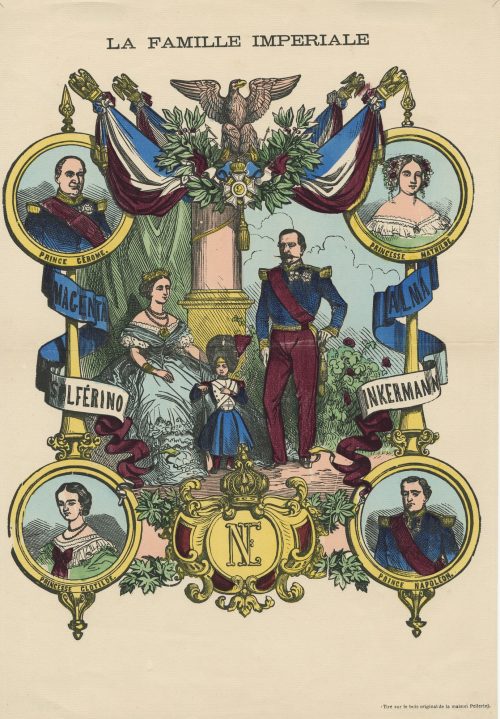 Hand-coloured woodcut on laid paper, 422 x 294 mm; black ink stamp “5307” to reverse, centrefold. Top center: "LA FAMILLE IMPERIALE"; Bottom right: "(Tire sur le bois original de maison Pellerin)". Image: Napoléon III, Empress Eugenie, and Prince Imperial Louis-Napoléon as a child surrounded with four lettered medallions: “PRINCE GÉROME”, “PRINCESSE MATHILDE”, “PRINCESSE CLOTILDE”, and “PRINCE NAPOLÉON”; ribbons lettered: “MAGENTA”, SOLFERINO”, “ALMA”, and “INKERMANN” around heraldic spears; coat of arms with imperial monogram between Princesse Clotilde and Prince Napoléon. Publisher/printer: Jean Charles Pellerin (French, 1756 – 1836). Battle of Magenta : 4 June 1859, against the Austrians. Battle of Solferino : 24 June 1859, against the Austrians. Battle of the Alma : 20 September 1854 (Crimean War) Battle of Inkerman : 5 November 1854 (Crimean War) Characters: Napoleon III [Charles-Louis Napoléon Bonaparte] (French, 1808 – 1873) Eugénie de Montijo [L'impératrice Eugénie] (Spanish-French, 1826 – 1920) Napoléon, Prince Imperial (Napoléon Eugène Louis Jean Joseph Bonaparte] (French, 1856 – 1879) Napoléon-Jérôme Bonaparte [Prince Jérôme] (French, 1822 – 1891) Mathilde Bonaparte [Princess Mathilde] (French, 1820 – 1904) Marie-Clotilde de Savoie [Princesse Clotilde] (French, 1843 – 1911)
Hand-coloured woodcut on laid paper, 422 x 294 mm; black ink stamp “5307” to reverse, centrefold. Top center: "LA FAMILLE IMPERIALE"; Bottom right: "(Tire sur le bois original de maison Pellerin)". Image: Napoléon III, Empress Eugenie, and Prince Imperial Louis-Napoléon as a child surrounded with four lettered medallions: “PRINCE GÉROME”, “PRINCESSE MATHILDE”, “PRINCESSE CLOTILDE”, and “PRINCE NAPOLÉON”; ribbons lettered: “MAGENTA”, SOLFERINO”, “ALMA”, and “INKERMANN” around heraldic spears; coat of arms with imperial monogram between Princesse Clotilde and Prince Napoléon. Publisher/printer: Jean Charles Pellerin (French, 1756 – 1836). Battle of Magenta : 4 June 1859, against the Austrians. Battle of Solferino : 24 June 1859, against the Austrians. Battle of the Alma : 20 September 1854 (Crimean War) Battle of Inkerman : 5 November 1854 (Crimean War) Characters: Napoleon III [Charles-Louis Napoléon Bonaparte] (French, 1808 – 1873) Eugénie de Montijo [L'impératrice Eugénie] (Spanish-French, 1826 – 1920) Napoléon, Prince Imperial (Napoléon Eugène Louis Jean Joseph Bonaparte] (French, 1856 – 1879) Napoléon-Jérôme Bonaparte [Prince Jérôme] (French, 1822 – 1891) Mathilde Bonaparte [Princess Mathilde] (French, 1820 – 1904) Marie-Clotilde de Savoie [Princesse Clotilde] (French, 1843 – 1911) -
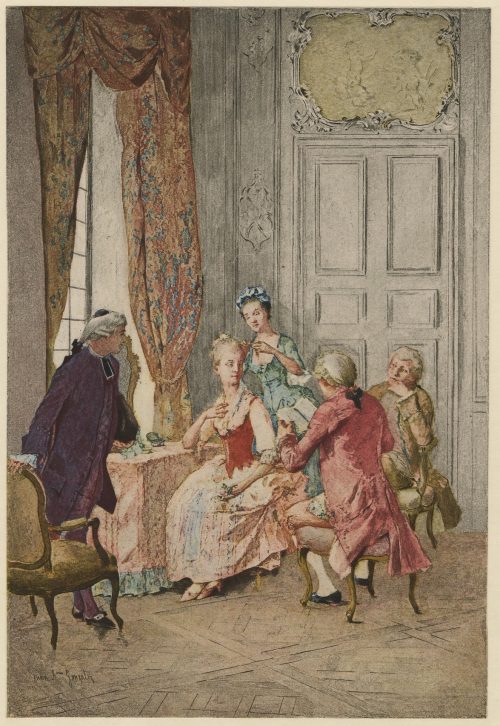
Coloured etching by E. Charreyre (French, fl. 1880 – ?) after a watercolour by Juan Antonio González, (Spanish, 1842 – 1914). A book illustration for 'Son Altesse La Femme' by Octave Uzanne (1851 – 1931), chapter: 'La Caillette' (Le lever d’une petite-maitresse au XVIIIe siècle). Published by Albert Quantin (French, 1850 – 1930) in 1885.
Size: print 17.5 x 12 cm, pasted to leaf 27.7 x 19.5 cm.
-
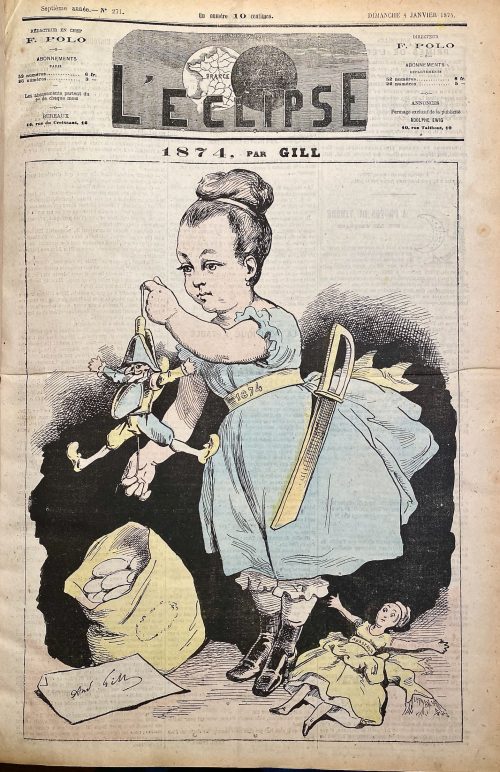 129 issues of L'Éclipse, French weekly political magazine; published in Paris, 49 x 34 cm, bound in rebacked green quarter morocco over marbled boards, with gilt fillets and lettering to spine, peacock marbled endpapers, illustrated by André Gill (French, 1840 – 1885). Founder and editor-in-chief François Polo (French, 1838 – 1874). 1874: 271-322 (52 issues) 1875: 323-374 (52 issues) 1876: 375-399 (25 issues)
129 issues of L'Éclipse, French weekly political magazine; published in Paris, 49 x 34 cm, bound in rebacked green quarter morocco over marbled boards, with gilt fillets and lettering to spine, peacock marbled endpapers, illustrated by André Gill (French, 1840 – 1885). Founder and editor-in-chief François Polo (French, 1838 – 1874). 1874: 271-322 (52 issues) 1875: 323-374 (52 issues) 1876: 375-399 (25 issues) -
 Woman Looking out a Round Window at a Woman with a Komusō Hat.
Woman Looking out a Round Window at a Woman with a Komusō Hat.Artist Koikawa Harumasa (a.k.a. Banki): fl. 1801–18. Wikipedia: Koikawa Harumasa (恋川 春政; active 1800–1820), later called Banki Harumasa (晩器 春政). Associated with Katsukawa school.
Signed: Banki ga (on the bamboo flower container in the background). Censor's seal: kiwame. Mark of unidentified publisher, Genshoku #1017; Marks U084 Ibiko, p. 387.
References:
Jacob Pins #828.
-
 Artist: Kitagawa Utamaro [喜多川 歌麿] (Japanese, c. 1753 – 1806) "This uncommon half-size horizontal ōban ... is most likely one design from a set of twelve prints issued late in Utamaro's life" [Japanese Erotic Fantasies, Hotei Publishing, 2005, p. 143, pl. 47]. Half-size horizontal ōban must be 12.7 x 38 cm. Richard Waldman and Chris Uhlenbeck say it's tanzaku size (13 x 43 cm). In reality, the prints of this series measure 17 x 38 cm, which corresponds exactly to horizontal o-hosoban paper size. I managed to assemble 11 of allegedly 12 designs. 7 of them have genitals colored by hand. It's hard to tell whether it was done by the publisher on demand of a peculiar buyer, or by the owner of the prints who considered the black and white privy parts unnatural. My sequencing of the prints is arbitrary. Transcription of the text may help find the correct order.
Artist: Kitagawa Utamaro [喜多川 歌麿] (Japanese, c. 1753 – 1806) "This uncommon half-size horizontal ōban ... is most likely one design from a set of twelve prints issued late in Utamaro's life" [Japanese Erotic Fantasies, Hotei Publishing, 2005, p. 143, pl. 47]. Half-size horizontal ōban must be 12.7 x 38 cm. Richard Waldman and Chris Uhlenbeck say it's tanzaku size (13 x 43 cm). In reality, the prints of this series measure 17 x 38 cm, which corresponds exactly to horizontal o-hosoban paper size. I managed to assemble 11 of allegedly 12 designs. 7 of them have genitals colored by hand. It's hard to tell whether it was done by the publisher on demand of a peculiar buyer, or by the owner of the prints who considered the black and white privy parts unnatural. My sequencing of the prints is arbitrary. Transcription of the text may help find the correct order. As Japanese Erotic Fantasies put it: "a couple engaged in love-making, their stare fixed outside the picture plane". This is the only image of series that has a reference in available western literature, and the only one found in museum collections: Rijksmuseum Amsterdam (RP-P-1999-2001-16); reference: Fukuda (ed.) (1990), pls. 11-2.
As Japanese Erotic Fantasies put it: "a couple engaged in love-making, their stare fixed outside the picture plane". This is the only image of series that has a reference in available western literature, and the only one found in museum collections: Rijksmuseum Amsterdam (RP-P-1999-2001-16); reference: Fukuda (ed.) (1990), pls. 11-2.
 The scene of this print looks quite similar to that of the Kiyonaga's Sode no maki:
The scene of this print looks quite similar to that of the Kiyonaga's Sode no maki:
 The woman is "a young lady-in-waiting of Shogun's Court or Daimyō's Mansion, enjoying a rare outing from her tedious chores" [Richard Lane]. She is fully dressed in her outer cloak (shikake), white paper hat (agebōshi or tsunokakushi), and toed socks (tabi). A book or maybe, onkotogami (roll of tissues known as 'paper for honourable act' ) is still in the folds of her kimono. She is holding an open fan, either to cover her and her lover's faces from an unsolicited witness or to bring some fresh air to their joined lips. The pair just started their sexual intercourse.
The woman is "a young lady-in-waiting of Shogun's Court or Daimyō's Mansion, enjoying a rare outing from her tedious chores" [Richard Lane]. She is fully dressed in her outer cloak (shikake), white paper hat (agebōshi or tsunokakushi), and toed socks (tabi). A book or maybe, onkotogami (roll of tissues known as 'paper for honourable act' ) is still in the folds of her kimono. She is holding an open fan, either to cover her and her lover's faces from an unsolicited witness or to bring some fresh air to their joined lips. The pair just started their sexual intercourse.
 A scene from medieval times. A courtier in eboshi cap having sex with an aristocratic young woman with a long straight hairstyle (suihatsu).
A scene from medieval times. A courtier in eboshi cap having sex with an aristocratic young woman with a long straight hairstyle (suihatsu).
 Completely naked couple in the moment of ejaculation. Lavish garments with paulownia leaves on a yellow background counterbalance the white bodies on red bedding. The form of a woman's cheeks is telling, but I don't know about what. Maybe her advanced age?
Completely naked couple in the moment of ejaculation. Lavish garments with paulownia leaves on a yellow background counterbalance the white bodies on red bedding. The form of a woman's cheeks is telling, but I don't know about what. Maybe her advanced age?
 The pose of the couple and the overall composition are similar to that of the previous sheet. Though the lovers are dressed, and the woman's hairdo is well kept. The male looks older and the woman - younger.
The pose of the couple and the overall composition are similar to that of the previous sheet. Though the lovers are dressed, and the woman's hairdo is well kept. The male looks older and the woman - younger.
 A man takes a young maid from behind. She clenches the sleeve of her kimono in her teeth; it's either the moment of penetration (beginning of intercourse) or of her orgasm (the end of it).
A man takes a young maid from behind. She clenches the sleeve of her kimono in her teeth; it's either the moment of penetration (beginning of intercourse) or of her orgasm (the end of it).
 This seems to be a forced intercourse between a lackey with extensive bodily hair and a young maid from the same household.
This seems to be a forced intercourse between a lackey with extensive bodily hair and a young maid from the same household.
 This design is very much like the other one presented below, which is described at Japanese Erotic Fantasies on page 136 (pl. 43b) as follows: "The viewer peers through a mosquito net to see a child fast asleep, while his mother or wet-nurse moves towards her partner. On our print there is no child; instead of a sleeping baby, there is a roll of onkotogami. Fewer objects make the overall image concise, almost laconic in comparison with the Ehon hana fubuki (1802) design:
This design is very much like the other one presented below, which is described at Japanese Erotic Fantasies on page 136 (pl. 43b) as follows: "The viewer peers through a mosquito net to see a child fast asleep, while his mother or wet-nurse moves towards her partner. On our print there is no child; instead of a sleeping baby, there is a roll of onkotogami. Fewer objects make the overall image concise, almost laconic in comparison with the Ehon hana fubuki (1802) design:

 A young couple in a moment of true love. He is listening to the beating of her heart.
A young couple in a moment of true love. He is listening to the beating of her heart.
 This is a moment of true love between an old monk and a young samurai. The latter even did not take of his socks (tabi).
This is a moment of true love between an old monk and a young samurai. The latter even did not take of his socks (tabi).
 From Japanese Erotic Fantasies: "Boats played a crucial role in the workings of Yoshiwara, as they were the primary means of transport to the district. During the hot summer months, trips on pleasure boats were also a favourite pastime. Sex aboard a boat is a recurrent theme in shunga".
The last print that I am currently lacking and hunting for:
From Japanese Erotic Fantasies: "Boats played a crucial role in the workings of Yoshiwara, as they were the primary means of transport to the district. During the hot summer months, trips on pleasure boats were also a favourite pastime. Sex aboard a boat is a recurrent theme in shunga".
The last print that I am currently lacking and hunting for:
 I know where it is, but I cannot reach it... yet.
I know where it is, but I cannot reach it... yet. -
 Kitagawa Utamaro. Illustration from the book Ehon koi no Onamaki. Cited at Hayashi Yoshikazu's 20-volume set Edo makura-e shi shusei: Kitagawa Utamaro. Size: Chuban (25.5 x 18.5 cm), two book pages glued together.
Kitagawa Utamaro. Illustration from the book Ehon koi no Onamaki. Cited at Hayashi Yoshikazu's 20-volume set Edo makura-e shi shusei: Kitagawa Utamaro. Size: Chuban (25.5 x 18.5 cm), two book pages glued together. -
 Kitagawa Utamaro. Illustration from book Ehon koi no Onamaki, published in 1799. Reference found by Chris Uhlenbeck: he found one of the designs in Hayashi Yoshikazu's 20-volume set Edo makura-e shi shusei: Kitagawa Utamaro. Size: Chuban (25.5 x 18.5 cm), two book pages glued together.
Kitagawa Utamaro. Illustration from book Ehon koi no Onamaki, published in 1799. Reference found by Chris Uhlenbeck: he found one of the designs in Hayashi Yoshikazu's 20-volume set Edo makura-e shi shusei: Kitagawa Utamaro. Size: Chuban (25.5 x 18.5 cm), two book pages glued together. -
 Kitagawa Utamaro. According to Chris Uhlenberg this is an illustration from the book Ehon koi no Onamaki, 3 vols, published in Kansei 11 (1799). Illustrated in b/w in: Hayashi Yoshikazu: Kitagawa Utamaro, in the series: Edo makura-e shi shusei, published in 1990, reissued 1994. Size: Chuban (25.5 x 18.5 cm), two book pages glued together.
Kitagawa Utamaro. According to Chris Uhlenberg this is an illustration from the book Ehon koi no Onamaki, 3 vols, published in Kansei 11 (1799). Illustrated in b/w in: Hayashi Yoshikazu: Kitagawa Utamaro, in the series: Edo makura-e shi shusei, published in 1990, reissued 1994. Size: Chuban (25.5 x 18.5 cm), two book pages glued together. -
 Kitagawa Utamaro (喜多川 歌麿; c. 1753 – 31 October 1806). Act III (Sandanme), from the series The Storehouse of Loyal Retainers (Chûshingura). Publisher Nishimuraya Yohachi (Eijudô). About 1801–02 (Kyôwa 1–2) Vertical ôban; 39.3 x 26 cm (15 1/2 x 10 1/4 in.). Reference: MFA ACCESSION NUMBER 11.14441 Ukiyo-e shûka 3 (1978), list #368.3; Shibui, Ukiyo-e zuten Utamaro (1964), 165.1.3; the series: Asano and Clark 1995, #s 383-5.
Kitagawa Utamaro (喜多川 歌麿; c. 1753 – 31 October 1806). Act III (Sandanme), from the series The Storehouse of Loyal Retainers (Chûshingura). Publisher Nishimuraya Yohachi (Eijudô). About 1801–02 (Kyôwa 1–2) Vertical ôban; 39.3 x 26 cm (15 1/2 x 10 1/4 in.). Reference: MFA ACCESSION NUMBER 11.14441 Ukiyo-e shûka 3 (1978), list #368.3; Shibui, Ukiyo-e zuten Utamaro (1964), 165.1.3; the series: Asano and Clark 1995, #s 383-5. -

Kitagawa Tsukimaro (Kikumaro): 喜多川 月麿, fl. c. 1794–1836.
Mother is playing with her child: they left playing with shadow lantern for freeing a turtle (Hojo-e, or "Rite for the Release of Living Beings").Signed: Tsukimaro hitsu (月麿筆); Publisher's mark; censor's seal: Kiwame + Yamaguchiya Tôbei gyōji seal (1811-14).
-
 Katsukawa Shun'ei. The Sumo Bout between Yotsuguruma (right) and Yamaoroshi (left). Date: 1800 or 1805/06. Similar sheet can be found at Edo Tokyo Museum. Size: Vertical Ōban. Sumo wrestler Yotsuguruma Daihachi (1772 - 1809) first appeared in the records of national tournaments in winter of 1794. Then he lost 3 matches and won zero. He first won in the spring tournament of 1797 in a match against maegashira (the fifth-highest rank of sumo wrestlers) named Kougamine. Yamaoroshi Gengo (born 1762) came in at the winter tournament of 1799 . He was much more successful in his career than Yotsuguruma, but he had never won a tournament. It was the time of great Raiden, who won most of them. In the spring tournament of 1800 Yotsuguruma and Yamaoroshi fought against each other for the first time. Yotsuguruma lost. The next time they met on the ring was at the winter tournament of 1805, and again in 1806. Both matches were won by Yamaoroshi. Yamaoroshi retired in 1809; Yotsuguruma died in 1809.
Katsukawa Shun'ei. The Sumo Bout between Yotsuguruma (right) and Yamaoroshi (left). Date: 1800 or 1805/06. Similar sheet can be found at Edo Tokyo Museum. Size: Vertical Ōban. Sumo wrestler Yotsuguruma Daihachi (1772 - 1809) first appeared in the records of national tournaments in winter of 1794. Then he lost 3 matches and won zero. He first won in the spring tournament of 1797 in a match against maegashira (the fifth-highest rank of sumo wrestlers) named Kougamine. Yamaoroshi Gengo (born 1762) came in at the winter tournament of 1799 . He was much more successful in his career than Yotsuguruma, but he had never won a tournament. It was the time of great Raiden, who won most of them. In the spring tournament of 1800 Yotsuguruma and Yamaoroshi fought against each other for the first time. Yotsuguruma lost. The next time they met on the ring was at the winter tournament of 1805, and again in 1806. Both matches were won by Yamaoroshi. Yamaoroshi retired in 1809; Yotsuguruma died in 1809.


